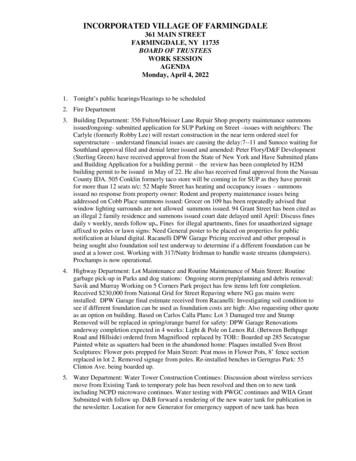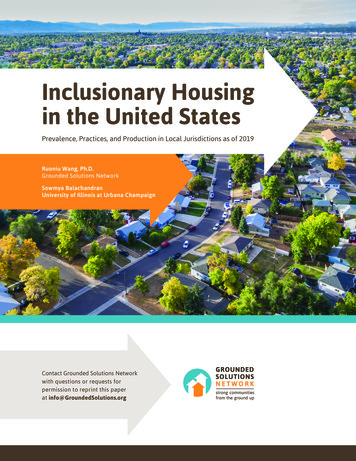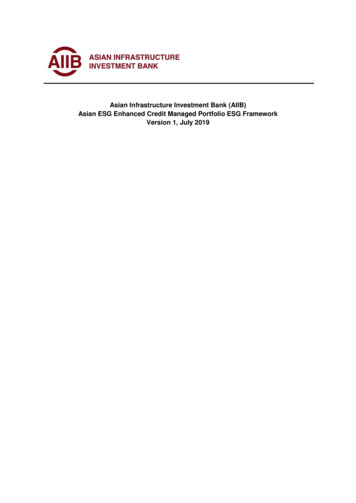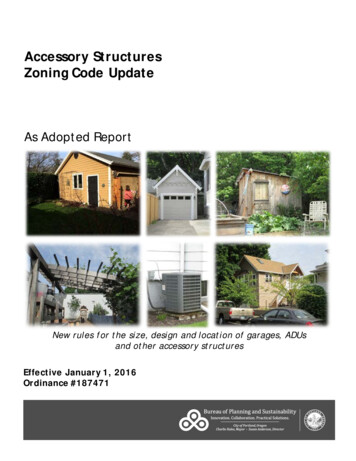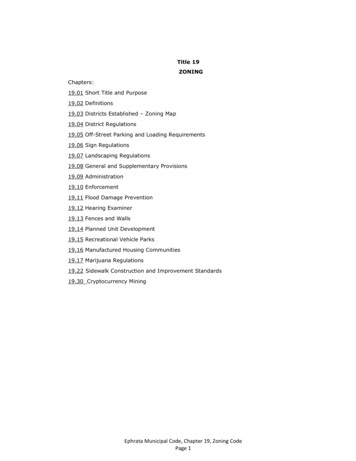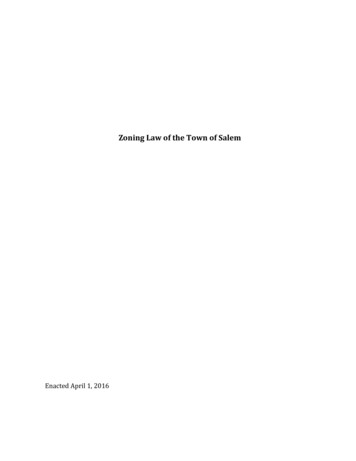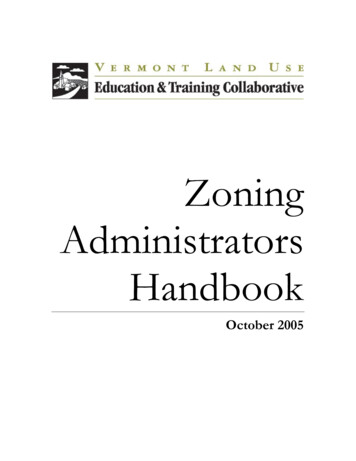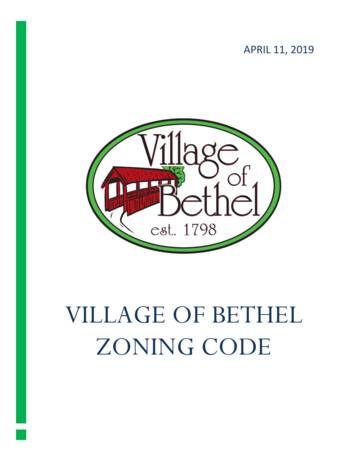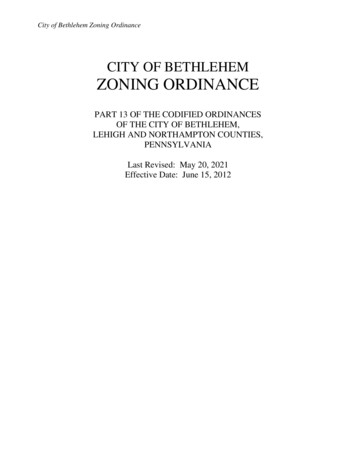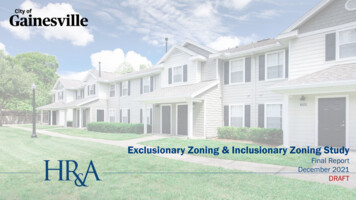
Transcription
DRAFT FOR DISCUSSION ONLYExclusionary Zoning & Inclusionary Zoning StudyFinal ReportDecember 2021DRAFT
DRAFT FOR DISCUSSION ONLYTABLE OF CONTENTSExecutive Summary4Existing Conditions: Housing Instability and Racial Inequity in Gainesville24Exclusionary Land Use Controls40Inclusionary Zoning Feasibility Study and Policy Recommendations56Appendix85Exclusionary Zoning & Inclusionary Housing Study 2
DRAFT FOR DISCUSSION ONLYAcknowledgementsHR&A Advisors thanks the individuals from City, County, and non-government organizations and industry stakeholderswho served as resources for our team throughout this study. In particular, we appreciate the time and thoughtfulfeedback provided by Gainesville City Commissioners and the study Steering Committee, and the direction providedby the Department of Sustainable Development.Dept. of Sustainable DevelopmentAndrew PersonsGainesville City CommissionersLauren Poe, MayorDavid ArreolaDesmon Duncan-WalkerAdrian Hayes-SantosReina SacoHarvey WardSteering CommitteeMissy DanielsCorey HarrisMalcolm KinerPhimetto LewisAnne RayStephen WeeksDavid WeissScott WinzelerHousing and Real Estate ProfessionalsKody GlazerChelsea BakaitisMalcolm KinerAdam BoltonMatthew MarinoBill CasonDanny RaulersonPamela DavisSarah VidalBlaise DentonMike WesemanEric DrummondJohn FlemingWe would also like to acknowledge formerCommissioner Gail Johnson.Exclusionary Zoning & Inclusionary Housing Study 3
DRAFT FOR DISCUSSION ONLYExecutive SummaryExclusionary Zoning/Inclusionary Housing Study 4
DRAFT FOR DISCUSSION ONLYProject Overview HR&A Advisors was engaged by the City of Gainesville to analyzethe causes of and potential strategies to address housing instability and racial inequities.This study responds to the following guiding questions:1. What drives housing instability and inequities in Gainesville?2. How do exclusionary land use controls drive local housing market trends?3. How can changes to exclusionary land use controls make housing in Gainesville more equitable?4. Is an inclusionary zoning policy a feasible and effective tool for producing new affordable housing in Gainesville?5. What other programs and policies are needed to address housing instability and inequities?Exclusionary Zoning & Inclusionary Housing Study 5
DRAFT FOR DISCUSSION ONLYProject Overview The City of Gainesville has been committed to creating a pathtoward an equitable housing landscape. This study is additive to these efforts.Recent Housing Efforts in Gainesville: Gainesville’s Housing Action Plan (2020) calls for diversifying funding sources,increased zoning flexibility, and permanent affordability. Gainesville’s current Comprehensive Planning Process includes a chapter exploringhousing strategies to house all Gainesville residents. The Gainesville Community Reinvestment Area has pursued urban infill housingand worked to attract investment to underserved parts of the city. The Gainesville Housing Authority has partnered with private developers tosubsidize permanently affordable housing. The Gainesville Housing and Community Development Department continues toadminister funding and programs through CDBG, HOME and SHIP programs.Exclusionary Zoning & Inclusionary Housing Study 6
DRAFT FOR DISCUSSION ONLYExisting Conditions An analysis of existing conditions in Gainesville reveals severaldistinct but related issues that are driving instability and unequal housing outcomes.Racial SegregationRacial SegregationIn Gainesville, race is a key determinant of where you live, access to diverse housing options andhomeownership, and the value of your home.Housing Cost BurdenExtreme housing cost burden, driven primarily by low incomes, is a key driver of housing instabilityin Gainesville.Housing Access and QualityNew rental housing in Gainesville has disproportionately benefited student renters, and nonstudent renters live in older, less diverse housing types as a result.Exclusionary Zoning/Inclusionary Housing Study 7
DRAFT FOR DISCUSSION ONLYExisting Conditions In Gainesville, race is a key determinant of where you live, youraccess to diverse housing options and homeownership, and the value of your home.Racial SegregationRacial SegregationShare of Non-Hispanic or Latinx white Households(Census Tracts, All) White households are more likely to live in single-familyhomes (which are typically owned, rather than rented). Gainesville’s Black population occupies “missing middle”housing, or buildings with 2-4 units, at a high raterelative to the population. These units tend to be moreaffordable in Gainesville. Homes in predominately white neighborhoods areassessed at higher values, increasing the wealth thataccrues to white households.LegendCity Boundary 75% white 40% whiteSource: Social Explorer – ACS 2019 (5-Year Estimates)Exclusionary Zoning/Inclusionary Housing Study 8
DRAFT FOR DISCUSSION ONLYExisting Conditions Extreme housing cost burden, driven primarily by low incomes, is akey driver of housing instability in Gainesville.Housing Cost BurdenRacial Segregation Renters across all racial groups earning 35Kannually experience high rates of housing cost burden. Race is a predictor of household income and povertyin Gainesville. Only white and Asian households earnabove Gainesville’s median household income. Blackhouseholds make 73% of the median. The average rental unit is currently only affordable tothe typical white or homeowner household inGainesville.Income at which Average Rental Unit isAffordable by Race (All) 50K 45K 40K 35K 30K 25K 20K 15K2010 2011 2012 2013 2014 2015 2016 2017 2018 2019Median Household Income (MHI)White MHIBlack MHIAsian MHIHispanic or Latinx MHISource: Social Explorer – ACS 2019 (5-Year Estimates)Household Income Needed to Afford the Average Rent per Unit (Costar)Exclusionary Zoning/Inclusionary Housing Study 9
DRAFT FOR DISCUSSION ONLYExisting Conditions The student housing market is the strongest rental market inGainesville. Non-student renters are not benefitting from new housing at the same rate.Racial SegregationHousingAccess and Quality Student renters are the primary beneficiaries of newrental housing development in Gainesville, which makesit more difficult for non-students to access such housing.Median Age by Census Tractand Student Housing*Legend 39 Years Student renters make up 36% of the total population butcomprise 50% of the population that lives in housingbuilt after 2000. 22 Years The average household in Gainesville struggles to accesshomeownership, especially Black, Hispanic or Latinx, andrenter households. As a result, 61% of households in theCity are renters. Less than a third of Black and Hispanicor Latinx households are homeowners.Built Pre-2010Source: Social Explorer – ACS 2019 (5-Year Estimates)PipelineBuilt Since 2010City BoundaryUniversity ofFlorida*Includes both student housing (i.e., housing that exclusively serves students) and student-focused housing(i.e., housing that caters to students but is available to all residents).Exclusionary Zoning/Inclusionary Housing Study 10
DRAFT FOR DISCUSSION ONLYLand Use This study explores how land use tools can help to create a housinglandscape in which who you are does not determine your housing options.While there are many housing tools, programs, and mechanisms that can improve housing equity andaffordability, this study is tasked with assessing two specific land use strategies.Land Use Tools use municipal regulations and zoning authority to indirectly improve affordability byincreasing the supply of housing and to directly require the production of affordable units.Subsidy Tools, in the form of below-market rate loans, grants, or other public resources, close the gapbetween what a household can afford to pay and the costs to develop and operate housing.Tenants’ Rights Tools preserve existing affordable housing and housing stability by using laws andregulations that protect current occupants.Exclusionary Zoning & Inclusionary Housing Study 11
DRAFT FOR DISCUSSION ONLYLand Use Land use mechanisms analyzed here include: (i) redressing exclusionarypolicies and (ii) implementing an inclusionary zoning program.In general, land use tools are most effective at addressing the housing needs of moderate-incomeresidents and are not effective at addressing the housing needs of low- and very low-income residents.Redressing exclusionary policies is a strategy to expand housing options throughout the city, creatinghousing opportunities for residents of all racial and economic statuses in places that households want and canafford to live in.Inclusionary zoning, while not necessarily the antidote to exclusionary zoning, is a strategy to produceregulated affordable housing for moderate income households in the private market by incentivizing,requiring, and/or subsidizing private housing developers to deliver new affordable housing when they buildnew market rate housing.These two land use strategies can, but don’t necessarily need to, work hand in hand. While this study focuses ontwo specific land use strategies, future housing plans should consider the full landscape of housing tools toincrease housing stability and equity in Gainesville, including subsidy and tenants’ rights tools.Exclusionary Zoning & Inclusionary Housing Study 12
DRAFT FOR DISCUSSION ONLYRecommendations This study makes recommendations on land use strategies that canhelp drive an equitable housing landscape in Gainesville.The City should redress existing exclusionary land use controls, with a particular focus on those that havethe highest exclusionary impact in Gainesville, including strict lot utilization and parcel constraints, strict designand compatibility requirements, and occupancy and mobile home limitations.The City should implement a mandatory IZ policy requiring that rental developments with at least 10residential units provide a 10 percent set-aside of units that are affordable to households earning up to80 percent of Area Median Income, offering a density bonus incentive of up to 30 percent. If possible, theCity should also explore additional incentives, such as a synthetic TIF, to deepen affordability (e.g., to createunits affordable to 60 percent of AMI).Both of these strategies should be used in combination with a set of housing tools to address the housing needsof low- and very low-income Gainesville residents, who have the highest housing need. HR&A recommends thatthe City of Gainesville work to identify revenue sources for an Affordable Housing Trust Fund and assess thepossibility of deploying local subsidy for affordable housing.Exclusionary Zoning & Inclusionary Housing Study 13
DRAFT FOR DISCUSSION ONLYExclusionary Land Use Controls Exclusionary land use controls exclude a diverse(often racially diverse) range of households from residential neighborhoods.Exclusionary lands use controls both directly limit the types of housing that can be built, and indirect limithousing access by contributing to prohibitive housing costs. While zoning is a recognizable land use control, it isone of many tools that local government uses to control how, where, and what kind of development occurs. County andState land use regulations and housing policy, such as HB 7103, also play a role in determining development patternsin Gainesville. HR&A developed criteria with which to review Gainesville’s Code of Ordinances.Exclusionary land use controls are local regulations that:1. Directly decrease or limit housing supply in residential areas (strict lot utilization andparcel constraints2. Increase the cost to build new housing (strict design and compatibility requirements)Each of these dynamicsdrives disparate outcomesby race.3. Limit the use of existing housing (strict occupancy limitations and mobile home locationlimitations)Exclusionary Zoning/Inclusionary Housing Study 14
DRAFT FOR DISCUSSION ONLYExclusionary Land Use Controls Changing exclusionary land use controls is animportant tool for reducing racial and economic exclusion across a housing market.Benefits of Changing Exclusionary LUCs: No public funding required to induce privatedevelopment Increases the overall supply of housing Can help address legacies of racial segregation bydriving new housing supply more evenly across the city Reduces the ability of a limited constituency to preventthe creation of housing Supports economic growth and expands the City’s taxbaseWithout reducing exclusionary landuse controls, all other housingstrategies, and those that requiresubsidy in particular, are lesseffective and more costly.Exclusionary Zoning & Inclusionary Housing Study 15
DRAFT FOR DISCUSSION ONLYExclusionary Land Use Controls The City of Gainesville should complete in-depth landuse analyses to consider the following changes to exclusionary land use controls.Actions to ConsiderOutcomes Reduce setbacks in low and moderate density residential areas.Permit lot splits in minor subdivisions.Reduce minimum lot dimensions.Allow housing typologies beyond single family ("missing middle", 2-4 unithousing) in residential districts with strict lot utilization constraints.1. Increase the amount andtype of housing in residentialareas Eliminate compatibility requirements between multifamily and single family uses.Reduce expensive design standards in historic preservation districts.2. Decrease the cost to buildand maintain housing Identify additional areas to permit mobile home uses.Eliminate single family occupancy limitations in low density districts.Increase the bedroom limit in the University of Florida Context Area when astructure includes more than one dwelling (attached housing).3. Increase options for the useof existing housingExclusionary Zoning & Inclusionary Housing Study 16
DRAFT FOR DISCUSSION ONLYInclusionary Zoning The goal of an inclusionary zoning policy is to supportGainesville’s housing needs through the creation of affordable housing.Inclusionary zoning is a land use tool that requires or encourages developersto create affordable units in new market-rate residential and commercialdevelopments. Incentives such as reduced parking requirements, additionaldensity allowances, or tax abatements are sometimes provided toencourage participation.More than 1000 jurisdictions across 30 states have inclusionary zoningprograms. These programs vary along many design considerations, includingwhether the program is voluntary or mandatory, what amount and depth ofaffordability is required, if it applies to rental or for-sale development,whether there are alternative compliance pathways such as the payment ofa fee in-lieu, and what incentives are available. These policy elements areadjusted based on local policy priorities, housing market strength, andaffordability needs.Illustrative IZ Policy with Density Bonus IncentiveWithout IZAll market-rateunitsWith IZ Additionaldensity AffordableunitsExclusionary Zoning & Inclusionary Housing Study 17
DRAFT FOR DISCUSSION ONLYInclusionary Zoning Inclusionary zoning is one of many tools that can support housingaffordability, and it presents a variety of benefits and limitations.Benefits of IZLimitations of IZCaptures value of land in areas with stronghousing markets. The Gainesville market has seensteady market-rate development in recent years insome neighborhoods, suggesting the potential tosupport development of some affordable housing.Does not work in weaker housing markets and submarkets, where an overlyrestrictive IZ policy risks decreasing housing development, which ultimatelyharms affordability by both failing to deliver the mandated IZ units and limitingoverall housing supply. An IZ policy that is overly restrictive relative to nearbyjurisdictions also risks driving new development outside of political boundaries.Serves households earning up to 80% of AreaMedian Income (AMI), which is an area of needfor Gainesville.Do not serve very deep levels of affordability need, such as for householdsearning up to 30% AMI. For these residents, other alternatives such as housingvouchers should be layered with increased supply of rent-restricted affordablehousing.Does not require public subsidy, though publicsubsidy may be provided as an incentive toachieve more or deeper affordability.Need to triangulate and optimize between maximizing depth of affordability,ensuring continued housing development, and limiting the cost of incentives.Exclusionary Zoning & Inclusionary Housing Study 18
DRAFT FOR DISCUSSION ONLYInclusionary Zoning HR&A tested the feasibility and impact of an inclusionary zoningpolicy in Gainesville and provided recommendations for policy design.FEASIBILITYANALYSIS1. Propose IZ scenarios totest, based on nationalprecedents2. Test IZ policy impact ondevelopment profitability3. Identify and evaluateincentive tools to narroweconomic gapPOLICYRECOMMENDATIONSPropose policy design,including elements like: Affordability depth Affordability duration In-lieu fee Unit pricing Unit characteristics Concurrency of unitdelivery Policy applicabilityADMINISTRATIVERECOMMENDATIONSOnce Gainesville hasdesigned and adopted an IZpolicy, it must administrate thepolicy through: Process Guidelines Development Approvals Program ManagementExclusionary Zoning & Inclusionary Housing Study 19
DRAFT FOR DISCUSSION ONLYInclusionary Zoning HR&A’s modeling finds that 10% and 8% IZ requirements bringproject profitability below threshold return requirements for all five typologies.Project profitability was measured using Yield on Cost, calculated for each property type using a 10-year cash flow model. Themodel was populated with assumptions gathered from empirical market data and developer interviews (see summary table ofassumptions in the Appendix). The calculations below give a sense of the average directional impact and relative magnitude ofpolicies. Falling below the return threshold does not mean every deal will die, but that fewer deals will happen; similarly, not everyproject above the return threshold will necessarily happen. Based on our model, the likely profitability gap for a developer perrequired affordable unit is between 16,000 to 140,000.Yield on Cost (ratio between stabilized NOI and development 4.00%Large GardenLarge MidriseMarket-Rate Rental10% AffordableInfill Midrise8% AffordableInfill HighriseSingle FamYield On Cost Return RequirementExclusionary Zoning & Inclusionary Housing Study 20
DRAFT FOR DISCUSSION ONLYInclusionary Zoning A range of incentives are available to overcome the gap inexpected financial returns.IncentiveProposalTradeoffsAdditional densityOffer up to 30% additional density (moreunits)Can deliver strong financial value for owners without directly spending publicdollars, but impact is limited if developers are currently building below existingland use regulations.Public landcontributionsWaive an appropriate portion of publicland costs (if density bonus is not sufficient)A highly valuable tool that reduces upfront development costs, but applicabilitymay be limited (based on City land holdings).Expedited reviewAlways prioritize and expedite review forIZ projects, target 2 weeksLittle to no cost to City; likely not valuable enough to be a “but for” incentiveBy-right developmentConsider by-right approvals for IZ projectsLittle to no cost to City; likely not valuable enough to be a “but for” incentiveSynthetic TaxIncrement FinancingExplore mechanism for tax-incrementfinancing to further deepen affordabilitySome cost to City, need to establish mechanism for residential properties, andrequires Council vote; offers way to provide valuable subsidy withoutcommitment of new dollarsDirect subsidyNot recommended unless reliable source offunding is identified and subsidy is usedtowards deepening affordability Parking developmentNot recommendedNot meaningful as parking requirements are already low, sometimes belowmarket demandNo sustainable, reliable source of ongoing fundingHighly valuable to developers, but costly to the City, and likely not thehighest-impact/efficiency use of limited housing funds
DRAFT FOR DISCUSSION ONLYInclusionary Zoning HR&A recommends that Gainesville adopt an IZ policy with a10% set-aside for households earning up to 80% AMI, with the option of an in-lieu fee.These requirements should be periodically reviewed and adjusted, every two years.Key Program Design ElementRecommendationSet Aside & Affordability Requirements: calibrating depth and amountof affordable units, vs. feasibility of requiring units 10% affordable units at 80% AMIIn-Lieu Fee / Flexibility for Compliance Establish in-lieu fee option, set at 120-160K per affordable unit thatwould have been built under IZ; adjust fee level every two yearsDevelopment Scale (Size of Developments Subject to IZ) Apply IZ requirements to multifamily residential developments with tenor more unitsApplicability (Voluntary vs. Mandatory, Applicability to ExistingDevelopments) Voluntary opt-in for geographies outside of IZ policyIncentives applicable to non-market rate unitsNot applicable to existing developmentAffordability Term / Duration 99 yearsUnit Pricing (based on household income and size) Follow existing HUD guidelinesUnit Characteristics Ensure affordable units are identical with market-rate unitsConcurrency of Delivery of Affordable Units Include a concurrency requirementFractional Units Adopt normal rounding rules, rounding up for fractional units above 0.5Exclusionary Zoning & Inclusionary Housing Study 22
DRAFT FOR DISCUSSION ONLYNext StepsExclusionary Land Use ControlsInclusionary Zoning Policy Provide guidance to the Department of SustainableDevelopment on key land use code elements for revision (all ora subset of those identified in this study). Explore priorities for affordable housing preservation andproduction to determine whether an inclusionary zoning policyis the highest-priority next step. Implement land use control changes through land use codechanges and other code or regulation changes, as needed.– If IZ is not the highest-priority policy, pursue alternatives,such as an affordable housing trust fund.– If IZ is the highest-priority policy, begin to prepare forimplementation by establishing an “owner” for policydesign and development.Exclusionary Zoning/Inclusionary Housing Study 23
DRAFT FOR DISCUSSION ONLYExisting Conditions: Housing Instability in GainesvilleExclusionary Zoning/Inclusionary Housing Study 24
DRAFT FOR DISCUSSION ONLYSeveral distinct but related issues are driving housing instability and unequal housingoutcomes in the City of Gainesville.Racial SegregationSegregationRacialIn Gainesville, race is a key determinant of where you live, access to diverse housing options andhomeownership, and the value of your home.Housing Cost BurdenExtreme housing cost burden, driven primarily by low incomes, is a key driver of housing instability inGainesville.Housing Access and QualityNew rental housing in Gainesville has disproportionately benefited student renters, and non-student renterslive in older, less diverse housing types as a result.Exclusionary Zoning & Inclusionary Housing Study 25
DRAFT FOR DISCUSSION ONLYGainesville’s population is predominately (55%) white. Black or African Americans arethe next largest racial group, making up 24% of the population.Percent of Total Population by Race (All)*54.6%23.9%11.6%6.3%WhiteBlack or AfricanAmericanHispanic or Latino*Charts and diagrams that are labeled ‘(All)’ include the student population.Asian3.1%Some Other Race0.3%0.1%American Indian and Native Hawaiian andAlaska NativeOther PacificIslanderSource: Social Explorer – ACS 2019 (5-Year Estimates)Exclusionary Zoning & Inclusionary Housing Study 26
DRAFT FOR DISCUSSION ONLYGainesville is racially segregated.White households are increasingly concentrated in west andnorthwest Gainesville, while Black households are concentratedin east Gainesville and increasingly in the southeast part ofthe City.UniversityParkInnovationUniversity of Florida DistrictRacial Dot Density Map (All) - Legend1 Dot 2 PeopleWhite OnlyBlack OnlyAsian OnlyHispanic/LatinxSource: Social Explorer – ACS 2019 (5-Year Estimates)Exclusionary Zoning & Inclusionary Housing Study 27
DRAFT FOR DISCUSSION ONLYRace directly shapes population change in Gainesville.In several areas, an increase in the Black population coincideswith a decrease in the non-Hispanic white population, and viceversa. Many of the census block groups to the south of NW 16thAve and along the Western portion of Gainesville areexperiencing growth in their Black population, while alsoexperiencing a loss in the white population. Northern Gainesvillein particular has seen a substantial growth in white householdswhile simultaneously losing Black households.Population Change by Race (All) - Legend 100% 100% 0% 100% 100% 0%Percent Change inBlack Population 0% 0%2010-2019Changewhite Pop. -25%Black Pop. 124%2010-2019Changewhite Pop. 337%Black Pop. -47%Percent Change inwhite PopulationSource: Social Explorer – ACS 2010, 2019 (5-Year Estimates)Exclusionary Zoning & Inclusionary Housing Study 28
DRAFT FOR DISCUSSION ONLYRace determines not only where people live in Gainesville, but also the type of housing inwhich they live.Gainesville’s Black population occupies “missing middle” housing, or buildings with 2-4 units, at a high rate relative to the population,while white households are underrepresented in this typology. White households are more likely to live in single-family homes (whichare typically owned, rather than rented) and large apartment complexes. The differences in occupancy by race reflect housingaffordability trends. In Gainesville, missing middle housing tends to be more affordable to low- and middle-income residentscompared to single-family homes and multifamily buildings.Share of Black Households by Housing Type(Non-Student)Overall ShareMobile Home or Trailer50 Apartments20-49 Apartments10-19 Apartments5-9 Apartments3-4 Apartments2 ApartmentsSingle Family AttachedSingle Family Detached21%30%18%40%38%33%46%63%16%22%Share of Non-Hispanic White Households byHousing Type (Non-Student)Overall ShareMobile Home or Trailer50 Apartments20-49 Apartments10-19 Apartments5-9 Apartments3-4 Apartments2 ApartmentsSingle Family AttachedSingle Family Detached61%58%63%56%49%55%45%32%63%66%Source: Public Use Microdata Sample (PUMS) ACS 2019 (5-Year Estimates)Exclusionary Zoning & Inclusionary Housing Study 29
DRAFT FOR DISCUSSION ONLYWhite households are more likely to own homes than non-white and or Hispanichouseholds, cementing a disparity in generational wealth-building.Tenure by Race (All)70%75%69%61%55%45%39%30%31%25%Owner-Occupied HouseholdsOverall ShareRenter-Occupied HouseholdsWhite ShareBlack ShareAsian ShareHispanic or Latinx ShareSource: Social Explorer – ACS 2019 (5-Year Estimates)Exclusionary Zoning & Inclusionary Housing Study 30
DRAFT FOR DISCUSSION ONLYPredominately white neighborhoods correlate with higher median assessed home values,increasing the wealth that accrues to white households.Share of Non-Hispanic or Latinxwhite Households(Census Tracts, All)Median Home Value(Census Tracts, All)LegendLegendCity BoundaryCity Boundary 75% white 195K 40% white 80KSource: Social Explorer – ACS 2019 (5-Year Estimates)Exclusionary Zoning & Inclusionary Housing Study 31
DRAFT FOR DISCUSSION ONLYLow household incomes, especially for renters, are a key driver of housing cost burdenand instability in Gainesville. Housing cost burden is defined by the cost of housing relative to incomes. Themore a household spends on housing costs, the less residual income it hasavailable for other basic needs, such as food and childcare. The medianhousehold income is about 37,000 in Gainesville, well below what it costs tomaintain a stable living standard. A household is considered cost burdened when it spends more than 30% of itsgross income on housing costs. This measure can be more impactful for lowerincome households, as they struggle to live with low residual incomes. When affordable rental housing is unavailable, low-income households facehousing instability and are more vulnerable to unsafe living conditions,overcrowding, and costly and harmful evictions.*EPI’s Family Budget Calculator measures the community-specific income a family needs in order to attain a modest yet adequate standard of living. Source: Economic Policy Institute, 2018Exclusionary Zoning & Inclusionary Housing Study 32
DRAFT FOR DISCUSSION ONLYRace is a strong predictor of household income. Only white and Asian households earnabove the median. Black households earn 73% of the median.Median Household Income by Race (All) 43K 40K 27KWhiteBlack or AfricanAmericanAsianPoverty Rate by Race (All)38.0%Gainesville MedianHousehold Income: 37K39.3%33.8% 30K28.7%Hispanic or LatinxWhiteGainesville OverallPoverty Rate:30.6%Black or African-AmericanAsianHispanic or LatinxSource: Social Explorer – ACS 2019 (5-Year Estimates)Exclusionary Zoning & Inclusionary Housing Study 33
DRAFT FOR DISCUSSION ONLYHomeownership remains unattainable for the average household in Gainesville,especially Black, Hispanic and renter households.Income at which Median Home is Affordableby Race (All) 50K 45K 40K 35K 30K 25K 20K 15KIncome at which Median Home is Affordableby Tenure (All) 75K 65K 55K 45K 35K 25K 15K2010 2011 2012 2013 2014 2015 2016 2017 2018 20192010 2011 2012 2013 2014 2015 2016 2017 2018 2019Median Household Income (MHI)White MHIBlack MHIMedian Household Income (MHI)Asian MHIOwner MHIHispanic or Latinx MHIRenter MHIHousehold Income Required to Afford the Median Home ValueHousehold Income Required to Afford the Median Home ValueSource: Social Explorer – ACS 2010-2019 (5-Year Estimates)Exclusionary Zoning & Inclusionary Housing Study 34
DRAFT FOR
Mobile homes are a form of naturally occurring affordable housing for lower-income residents. Such homes (as well as other alternative formatssuch as tiny homes) provide more flexible and financially attainable living arrangements compared to traditional single- or multifamily units.
